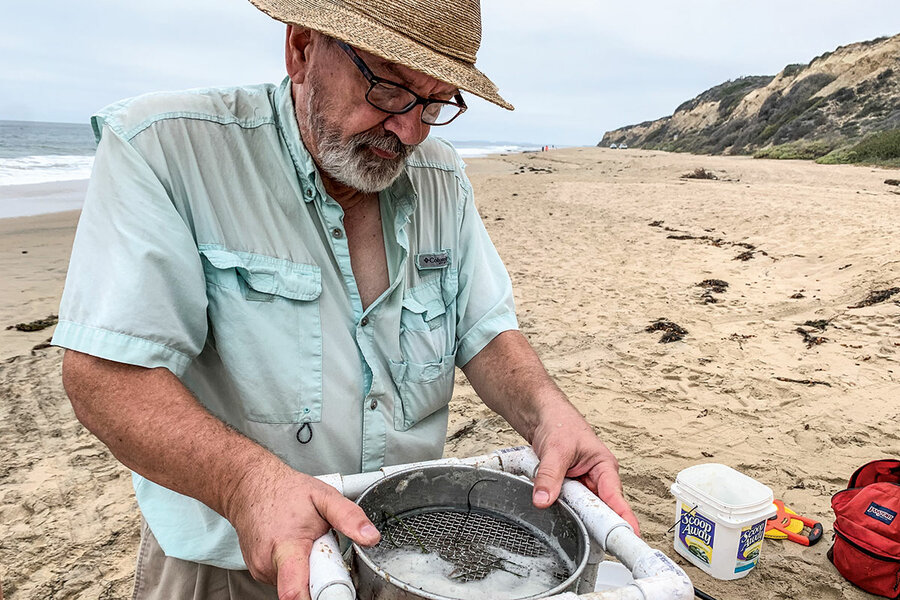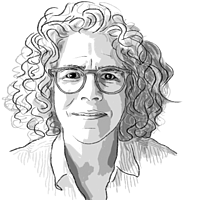Meet the nurdle hunter combing the beach for hidden pollution
Loading...
| Crystal Cove State Park, Calif.
You have to look close – on-your-hands-and-knees close. Once you start to see them, you may not think of this, or any beach, the same way again.
Mark McReynolds is trying to bring these tiny preproduction plastic pellets known as nurdles into focus. They’ve been escaping factories, container ships, trains, trucks – and public notice – for decades. They accumulate where water inevitably takes them, and they’ve been found on shorelines of every continent.
Why We Wrote This
How do you curb a problem that’s hidden in plain sight? Mark McReynolds’ nurdle hunters scour the sands for a tiny pollutant most beachgoers don’t even know exists.
Dr. McReynolds and his citizen scientist volunteers are part of a global movement studying the nurdle trail into the environment. He conducts a complex monthly microplastic sampling and a twice-annual nurdle hunt. Charting the count, noting tide, current, and weather conditions will show if amounts are increasing, and perhaps at what rate and why.
“Knowledge opens your eyes,” he says. So he explains the science of nurdles and microplastics to curious beachwalkers while keeping an eye on volunteers troweling sand into 5-gallon buckets.
In the six months the Monitor has observed the beach surveys, the universal parting response from passersby is a variation of “Thank you for what you’re doing.”
This 3-mile stretch of sand and tide pools beneath a fortress of 80-foot bluffs is a California tourism poster if there ever was one. Nothing disturbs the pristine, sunny view, except – once you’re aware of them – the nurdles.
But you have to look close – on-your-hands-and-knees close – to see one. And once you do, you see another and another – so many that you may not think of this, or any beach, the same way again.
Mark McReynolds is trying to bring into focus these tiny preproduction plastic pellets that manufacturers melt down to mold everything from car bumpers to toothpaste caps. They’ve been escaping factories, container ships, trains, trucks – and public notice – for decades.
Why We Wrote This
How do you curb a problem that’s hidden in plain sight? Mark McReynolds’ nurdle hunters scour the sands for a tiny pollutant most beachgoers don’t even know exists.
Dr. McReynolds is an environmental scientist with the Christian conservation nonprofit A Rocha International who’d never heard of nurdles three years ago. He’s now joined a global movement studying their trail into the environment. Some – like the Great Nurdle Hunt and the Nurdle Patrol – map nurdles through informal online reporting by citizen scientists around the globe.
“Knowledge opens your eyes. You don’t see plastic bags blowing around [on this beach] because people pick them up,” says Dr. McReynolds. “But, they’re not picking up the stuff that’s 3 millimeters [because] they don’t even know it’s there.”
The 2- to 3-millimeter, multicolored orbs are a subset of microplastics – plastic particles less than 5 millimeters in size. Nurdles accumulate where water inevitably takes them, and they’ve been found on shorelines of every continent.
Establishing a baseline count of the presence of nurdles – and, more broadly, any microplastics – is the focus of Dr. McReynolds’ scientific study here. Charting the count, noting tide, current, and weather conditions will show if amounts are increasing, and perhaps at what rate and why. That knowledge, he says, can inform solutions to plastic pollution such as regulation of their use.
Aided by citizen science volunteers – and his wife, Karen McReynolds, an associate professor of science at Hope International University who offers access to a lab and student help – he conducts a complex monthly microplastic sampling and a twice-annual nurdle hunt.
Microplastics research and cleanups have “exploded” in the past decade due to new “understanding of the apparent health and ecosystem risks,” says Erica Cirino, whose book “Thicker than Water: The Quest for Solutions to the Plastic Crisis” is a tale of adventure chasing microplastics around the globe.
In her travels she’s been struck by how unifying the plastic problem can be for people from diverse groups – from faith-based organizations to surfers and fishers, conservatives to liberals. They don’t all know what to do about it, she says, but “a very concrete thing like a [nurdle] hunt or getting your hands dirty is one of the best ways to get people involved.”
It’s science, not a trash pickup
“What are you doing? Picking up trash?” queries a steady stream of beach walkers whenever Dr. McReynolds’ crew trundles onto the beach and sets up gear.
Whether it’s a timed hunt, picking colorful nurdles out of the sand and vegetation during a 15-minute period, or a monthly microplastics collection, the scene suggests no ordinary beach pickup: It’s a colorful jumble of flags and measuring tape to create GPS-recorded 100-meter transects and buckets full of seawater lugged from the waves to sieve plastics out of collected sand.
These are teachable moments for Dr. McReynolds, whose passion for the environment involves faith in God’s earthly creation thoughtfully reconciled with the scientific method (he has a Ph.D. in environmental studies and a master’s degree in divinity). He explains the science of nurdles and microplastics to the curious while keeping an eye on volunteers troweling sand into 5-gallon buckets. Each bucket of sand can yield anywhere from no plastics to as much as 300 pieces to be analyzed in the lab. It sounds small, but the randomized samples can be extrapolated to the rest of the beach.
His state park research permit requires a public education element, and Dr. McReynolds displays laminated explainers with photos of piles of multicolored nurdles.
One recent morning he told some beach walkers how nurdles are believed to absorb toxic chemicals, and – because they resemble fish eggs – are eaten by fish and birds and enter the food chain. Almost on cue, a bold seagull hopped up to a laminated photo of nurdles and hungrily pecked at it.
A lonely devotion
A scarlet macaw expert by training, and an ordained Mennonite pastor who holds outdoor church services in the nearby San Gabriel Mountains, Dr. McReynolds is an unpaid director of A Rocha’s Southern California operations – which means he’s as much a volunteer as his citizen scientist recruits.
And it can be a lonely devotion, says his wife Karen, who notes that he possesses “bulldog grab-it-and-do-not-let-go” tendencies to bridge science and faith. His A Rocha colleague, Bob Sluka, says it’s Mr. McReynolds’ “pastoral heart” that drives the Crystal Cove microplastics survey and its potential to spur people “to recognize things they are doing in their own life as consumers and change their behavior.”
Indeed, notes Grace Hadinata, a former environmental engineer who volunteers to analyze microplastics at the lab and gathering them at the beach. She has come to some deeper understanding. Picking through a jar of debris in the lab, sorting nurdles from Styrofoam-like crumbs and gardening perlite, she says the survey’s importance boils down to this: “People at the beach have no idea nurdles are there unless they’re reading one of our flyers, right? If we don’t do anything about [nurdles], they’re just going to accumulate.”
How bad is bad?
Dr. McReynolds holds a balanced view of ubiquitous plastics: “It’s a question that we’re going to be asking for a while. Because although there is some good [in plastics], there’s certainly some bad, and we don’t know how bad the bad is.”
Asked about nurdles and efforts like Dr. McReynolds’, George O’Connor, a spokesperson for the Plastics Industry Association, wrote: “The foundation of the plastics industry is scientific research, so we consider all types of scientific data to inform and improve our operations.”
Dr. McReynolds’ Crystal Cove study, now in its second year, is well on its way to showing that microplastics are present and collect here via local ocean current. It’s an incremental, but important, bit of baseline evidence in the early science on the subject.
Will it help save the world? Mr. McReynolds wags a finger at that idea: “I won’t ever use that word. ... I won’t save the world from this pollution problem. Preserve it, yes. We want to take care of it.”
Even diverse strangers new to nurdles seem to recognize that motive.
In the six months the Monitor has observed the beach surveys, the universal parting response from passersby is a variation of “Thank you for what you’re doing.”











